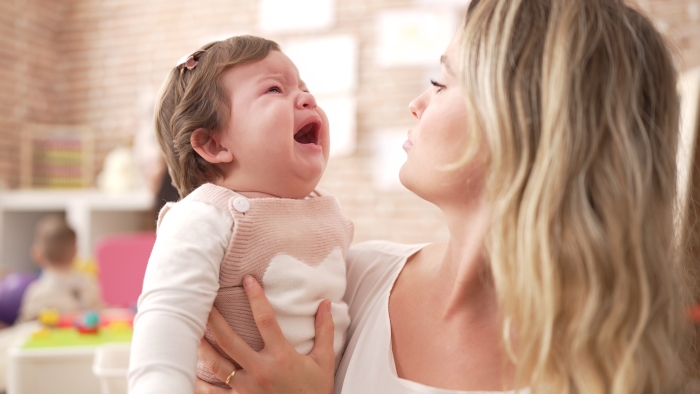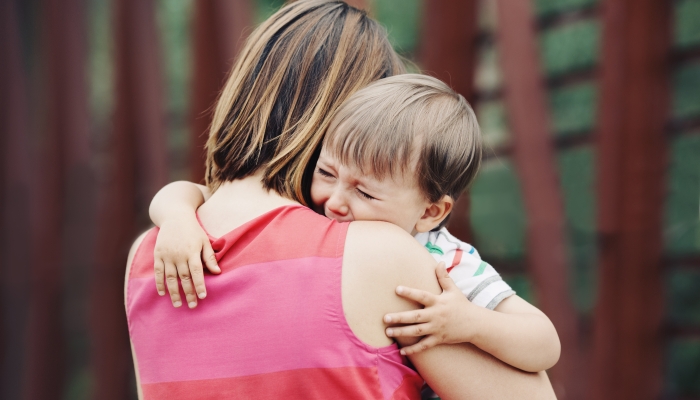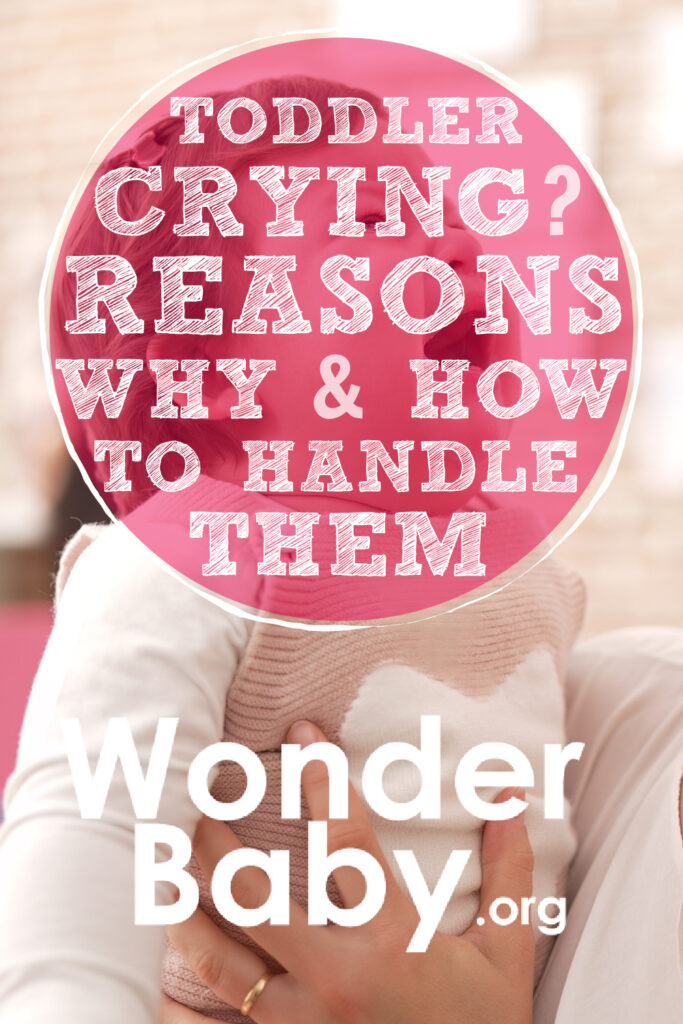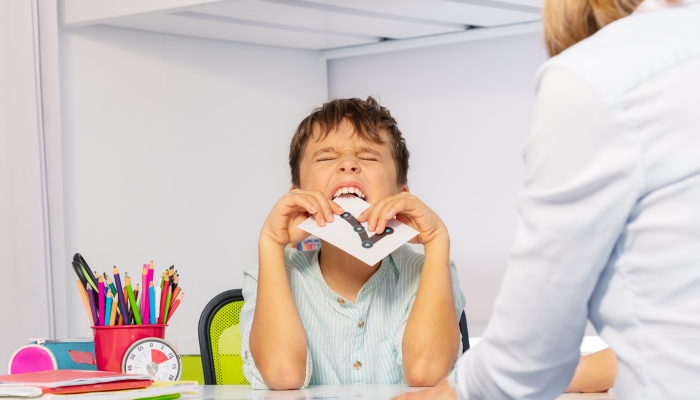Toddler Crying? 6 Reasons Why and How to Handle Them

This post may contain affiliate links; please see our terms of use for details.
- Toddler crying and tantrums are a normal and healthy phase of development.
- Your toddler is crying for a reason and is trying to communicate something to you.
- Toddlers may cry because they are hungry, angry, lonely, or tired.
- Remain calm, validate, and support your toddler to help them regulate.
- Talk with your pediatrician if your toddler cries, screams, or has a tantrum for long periods of time and doesn’t calm down within 15 minutes.
Your day was going smoothly and then you handed your child the red cup. Before you know it, your child is crying on the floor. Over a cup.
Is your toddler crying over what feels like little things often? You’re not alone. As a parenting coach, this is one of the biggest concerns for many parents of toddlers.
Toddler crying and tantrums are exhausting. Understanding toddler crying and the reasons they cry can help you support your child through this normal phase of development.
Toddler Crying a Lot: Is It Normal?
As a newborn, your baby communicated through crying. And now your child’s brain is rapidly developing.
Your child is learning they are separate from you, an individual person, and an independent one at that! It’s common to hear the phrase “I do it!” a lot at this stage. Of course, this is frustrating, but toddlers’ crying and tantrums are a normal and healthy phase of development.
Toddlers are no longer crying just to get their basic needs met, as they did as an infant. An infant uses the downstairs, primitive part of their brain that is already developed at birth. As a baby grows, they begin using their upstairs brain, which is still under construction.
The upstairs part of the brain (the prefrontal cortex primarily) is responsible for our logic, reasoning, and impulse control. It starts rapidly developing in toddlerhood but doesn’t finish developing until around 25 years of age.
- Amazon Kindle Edition
- Siegel, Daniel J. (Author)
- English (Publication Language)
- 220 Pages – 10/04/2011 (Publication Date) – Delacorte Press (Publisher)
According to Daniel Siegel, M.D. and Tina Payne Bryson, Ph.D., in the book The Whole Brain Child, our upstairs and downstairs brain works together when we are calm and regulated. When we have a tantrum or are dysregulated, our downstairs brain disconnects and we no longer use logic or reasoning. Instead, we fight, flight, or freeze. This happens often for your toddler.
It is okay for your child to cry often, but most children will calm down within 15 minutes after getting upset. Some kids are more sensitive or emotional and might cry more than other toddlers their age, but this is not a developmental concern.

6 Reasons Why Toddlers Cry
Your child might not know why they are dysregulated, but you can help to identify the reason. Focusing on the reason why your toddler is crying can help you either prevent the dysregulation or better help your child through their time of need.
Many mental health therapists helping clients with emotional dysregulation discuss the acronym ‘HALT.’ In the midst of a big emotion, ask yourself, “Am I Hungry, Angry, Lonely, or Tired?” We can apply this same acronym with children (plus a few other reasons).
1. Hungry
Toddlers’ brains aren’t the only thing growing. During a toddler growth spurt, your child is physically getting bigger, too, and needs food. If your toddler is emotional, he might just be hungry. Growing children eat often, so keep some healthy snacks handy wherever you go.
2. Angry
Sometimes young kids cry when they are upset about something that just happened. They might be angry, sad, stressed, or frustrated. It’s possible they want something (right now!) that they can’t have. Sometimes this looks like toddler aggression. Younger children aren’t able to use words to describe feelings yet and may cry to express their emotions.
3. Lonely
Sometimes grown-ups say a child is crying to get attention. And this might be true. If your young child is feeling lonely or bored, they may cry.
4. Tired
Due to rapid brain growth, children need a lot of sleep to mentally recover. According to the Sleep and Medicine Research Center of St. Luke’s Hospital in St. Louis, MO, a two-year-old needs an average of 13 hours of sleep in 24 hours, while a three-year-old needs 12 ½ hours of sleep. It is hard to stay regulated when overtired. If your kid struggles with crying often, ensure they are getting enough sleep.
5. Uncomfortable
Sometimes children cry if they are too hot, cold, in pain, or sick. If your child is experiencing physical discomfort, they might cry a lot. When our body doesn’t feel comfortable, we tend to be more irritable.
6. Overstimulated
Our brains can only handle so much information at a time. Sensory overload can occur when there is a lot going on around you, such as noises, lights, or movement. When it becomes too much for your child’s brain to process, they might start crying more.
Is It Okay To Let a Toddler Cry It Out?
Crying can be healthy. Sometimes we need to release the emotion we are feeling and a good cry can help. It is healthy to let your toddler cry.
Your job as a parent isn’t to get your child to stop crying but instead to support them while they cry.
When your child is having a big emotion (or tantrum), allow them to cry it out, but stay with them. You want your child to know they can trust you to support them through difficult things. A crying child is exhausting, especially if it seems to be for “no reason.” But remember, there is always a reason why they are crying. And to them, it is important.

Tips On How To Handle a Crying Toddler
It’s hard when your kid cries. Especially when your kid cries a lot, it can be emotionally exhausting. Understanding your toddler’s brain development, remaining calm, and following through with limits can help you and your child through this hard phase of development.
Self-Care
One of the most important tips for handling toddler tantrums is taking care of yourself. Make sure you’re getting rest, nutrition, and your physical and social needs met. It’s hard to care for others and remain calm when you’re depleted. Take a deep breath, reach out to your support network, and get breaks when possible.
Sleep Hygiene
Make sure your toddler is getting an adequate amount of sleep. If it takes your kid a long time to fall asleep, they are probably over-tired. Focus on your toddler’s sleep schedule to offer time for your child’s brain to start winding down too. Read books and snuggle to connect before bed.
Offer Choices With Limits
Try to prevent some tantrums by offering choices with limits and following through. Your child needs you to be kind, consistent, and reliable. Your child will learn that it’s okay to be mad when they don’t get the extra cookie but that you’re not going to give in, either.
When offering a choice, allow your child at least 10 seconds before following through. Choices can be:
- Do you want one cookie or no cookies?
- Do you want to hold my hand or do you need me to carry you?
- Do you want to get in your car seat or do you need me to help you?
If your child can’t decide after 10 seconds, help them by saying “It looks like you need my help this time. I’ll help you get in the car seat and next time you can try.” And then calmly follow through.
Offer a Time-In Instead of Time-Out
When your child is having a big emotion, they need your help. Instead of sending them to time-out, offer to stay beside them. Remain calm and validate your child’s feelings. Empathize and offer support while keeping your limit. You can say, “I understand you’re mad. It’s okay to be mad, but I won’t let you hurt me.”
Use the time-in to offer coping skills but don’t lecture. It is not the time to teach your child a lesson or discuss what they did wrong but instead a time to support them. Get down on their level. Take deep breaths together. Give them permission to feel the feeling. Let them cry or pout. Once they are calm and ready, you can talk about what to do differently next time.
When Should You Worry About Your Toddler’s Crying?
If your child cries, screams, or has a tantrum for long periods of time and doesn’t calm down within 15 minutes, seek professional help. Speak with your pediatrician to rule out any medical concerns, like an ear infection, that might be causing pain for your child.
Talk with your pediatrician if you are concerned with your child’s behavior. Together your pediatrician can discuss if your toddler’s crying is a developmental concern.

Related Posts

Behavior
Understanding Intermittent Explosive Disorder in Children
Are you worried about your child’s unexpected aggression and explosive behaviors? Learn how to support a child with intermittent explosive disorder.

Behavior
5 Emotional Regulation Activities for Kids
Want to teach your child how to regulate emotions? Here are emotional regulation activities for kids that can help!

Behavior, Special Needs
5 Tips for Dining Out with Children Who Have Sensory Sensitivities
Worried about dining out with sensory sensitivities? Try these tips for less stress and more fun the next time you take your family out to eat.
